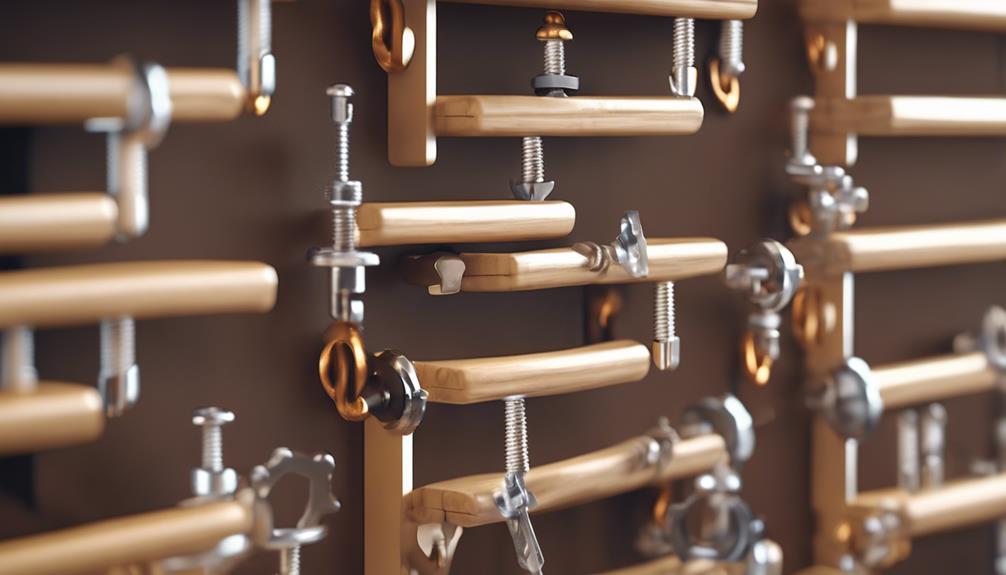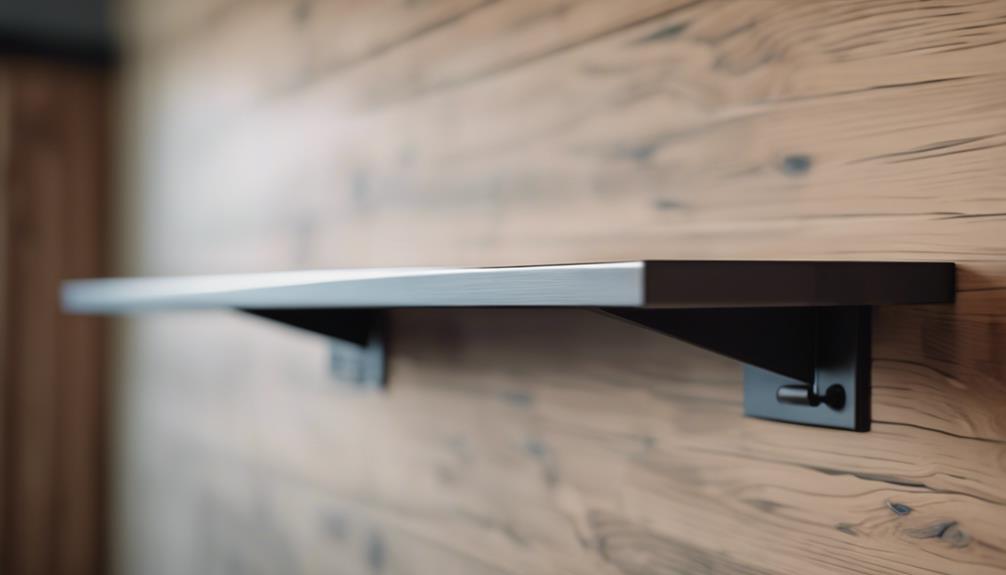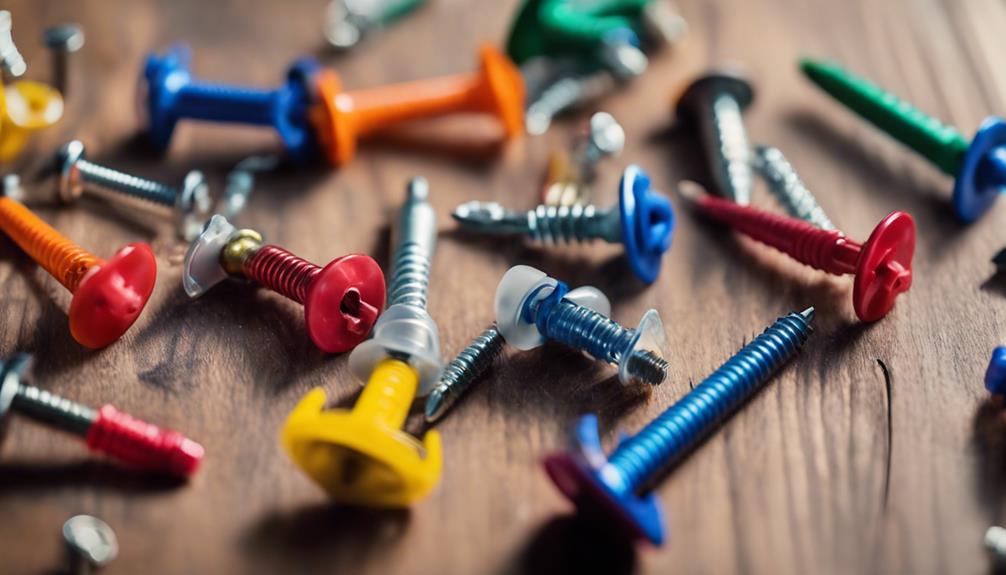Different Types of Anchors for Floating Wood Shelves

When setting up floating wood shelves, it's crucial to choose the right anchors to ensure sturdy support and prevent any potential sagging.
Steel threaded rods are a reliable option known for their exceptional strength and durability, making them ideal for holding up heavier loads with ease.
Lag bolts, requiring pre-drilled pilot holes for a secure attachment, boast a robust capacity of 200 to 300 pounds, making them a dependable choice for anchoring shelves.
Steel angle brackets, designed in an L-shape, provide efficient load-bearing support by securing to both the wall studs and the underside of the shelf. This design ensures a strong connection, offering stability and peace of mind when displaying items on the shelf.
Torsion box shelves, with their grid core structure, distribute weight evenly across the surface, enhancing stability and minimizing the risk of any potential warping or bending over time.
For installations where wall studs are not available, drywall anchors like Toggler Mini Snap-Skru come in handy, offering a secure attachment option for floating wood shelves. These anchors are designed to hold up well in drywall, providing a reliable solution for anchoring shelves in locations where traditional methods may not be applicable.
Each type of anchor brings its own unique strengths to the table, ensuring solid and durable support for your shelves based on the specific requirements of your project. Choose the anchor that best suits your needs and enjoy a well-supported and stylish display for your space.
Key Takeaways
- Steel Threaded Rods: These rods offer robust support by being directly drilled into the wood shelves and studs, ensuring long-term stability and preventing any bending or sagging over time. They are highly recommended for heavy-duty floating wood shelves.
- Lag Bolts: Known for their heavy-duty nature, lag bolts have impressive weight capacities ranging from 200 to 300 pounds per bolt. By securely fastening the shelves through pre-drilled pilot holes into studs, lag bolts provide reliable support for your floating wood shelves.
- Steel Angle Brackets: Featuring an L-shaped design, steel angle brackets attach to both the wall and the underside of the shelf, creating a strong connection to the studs. This design ensures efficient load-bearing capabilities, making it a popular choice for floating wood shelf installation.
- Torsion Box Shelves: These shelves are engineered with a grid core structure that allows for even weight distribution, providing unparalleled strength and stability. Their design not only ensures a sturdy foundation for your floating wood shelves but also facilitates easy installation.
- Drywall Anchors: When wall studs are not available, drywall anchors come to the rescue. One popular option is the Toggler Mini Snap-Skru anchors, known for their reliable and secure attachment to drywall. These anchors are a great choice for ensuring the stability of your floating wood shelves without the need for studs.
Steel Threaded Rods
Steel threaded rods are the go-to choice for securely mounting floating wood shelves. These rods, typically measuring 12 inches x 5/8 inch, are specifically crafted to provide exceptional support for our shelves. By drilling them directly into the wood shelves and corresponding studs, we ensure unparalleled stability. This innovative approach evenly distributes weight across the shelf, effectively preventing any sagging or bending over time.
The installation process is simple yet highly effective. Precise holes need to be drilled into both the shelf and the wall studs to accommodate the steel threaded rods. Securing the rods in epoxy with spacers adds an extra layer of reinforcement, making them perfect for supporting heavy items without the risk of collapse. When properly installed, these rods create a robust and long-lasting mounting solution.
Lag Bolts
Let's delve into another anchoring method for floating wood shelves: lag bolts. These heavy-duty fasteners are crafted to provide robust support and stability, making them perfect for securing hefty shelves. With impressive weight capacities ranging from 200 to 300 pounds per bolt, lag bolts ensure that even the heaviest shelves stay firmly attached to the wall.
For proper installation, it's crucial to pre-drill pilot holes into studs or solid wood. This not only streamlines the process but also prevents wood from splitting. The length of lag bolts should be a minimum of 2.5 inches to ensure a secure attachment, but opting for lengths up to 5 inches can offer enhanced stability.
Achieving reliable anchoring with lag bolts depends on precise execution. Pre-drilling guarantees that the bolts can be driven in without compromising the wall or shelf's integrity. Once in place, these bolts provide dependable support, making them a preferred choice for innovative shelving solutions where weight and stability are paramount.
In essence, lag bolts epitomize the sturdy reliability we seek in heavy-duty fasteners. When installed correctly, they elevate floating wood shelves from mere decor to functional, trustworthy storage solutions.
Steel Angle Brackets

Steel angle brackets, characterized by their L-shaped design, offer robust support by attaching both to the wall and the underside of the shelf. They're a popular choice for individuals seeking a blend of innovative design and reliable functionality. When steel angle brackets are installed, they not only provide support but also reinforce the floating wood shelves for maximum stability.
These brackets are available in various sizes and weight capacities, ensuring versatility for different shelf dimensions and loads. By selecting the appropriate size, we can ensure that our shelves can support the intended weight without compromising safety or aesthetics. Securing the brackets to wall studs using screws is crucial. This method ensures efficient load-bearing capabilities, offering the strong support necessary for our shelves.
The installation process is straightforward but requires precision. Proper alignment and secure attachment to the wall studs are essential steps in maintaining the stability of our floating wood shelves.
Steel angle brackets offer a durable and reliable solution, making them an excellent option for individuals seeking to establish a secure and stylish shelving system. With these brackets, we achieve not only support but also long-lasting reinforcement.
Torsion Box Shelves
Floating wood shelves provide exceptional stability and strength due to their innovative torsion box design, making them an ideal choice for supporting heavy items. The grid core structure, sandwiched between two layers, ensures even weight distribution, reducing the risk of warping or sagging over time. This unique construction guarantees long-lasting durability, maintaining the shelves' form and functionality even under significant loads.
When compared to traditional shelves, the grid core of torsion box shelves allows for a more uniform distribution of weight, preventing any potential issues like sagging or warping. Their lightweight design makes them easy to install and handle, offering convenience during the setup process. Additionally, the durable structure of these shelves ensures they can withstand heavy items without compromising their integrity.
The versatility of torsion box shelves extends to their ability to be customized to fit various sizes and shapes, catering to different design preferences. Their innovative construction provides unmatched stability and strength, making them a wise investment for those seeking durable floating shelves.
This advanced shelving solution not only supports heavy items effectively but also enhances the aesthetics of any modern home or workspace. By embracing the technology behind torsion box shelves, individuals can add a reliable and long-lasting storage solution to their living or working environment.
Drywall Anchors

Securing floating wood shelves without access to wall studs can be a challenge, but drywall anchors provide a reliable solution. These anchors offer the necessary support to keep your shelves stable and safe, even when you can't locate a stud in the wall. Drywall anchors come in various types, each with different weight capacities, ranging from light to heavy-duty options. Among these, Toggler Mini Snap-Skru anchors stand out as a popular choice for securing shelf brackets directly into drywall.
To ensure a successful installation, it's essential to follow a few critical steps:
- Locate the Installation Spot: Use a stud finder to confirm the absence of a stud at the desired location and mark the spots for the shelf brackets.
- Drill a Pilot Hole: Before inserting the drywall anchors, drill a pilot hole. This step helps the anchor to go in smoothly and ensures a better grip.
- Insert Drywall Anchors: Place the anchors into the pilot holes. As they expand behind the wall, they create a firm hold for your shelves.
- Attach Shelf Brackets: Securely attach the shelf brackets using screws and anchors. For heavier floating shelves, consider using wood screws for added stability.
Frequently Asked Questions
What Anchors Are Best for Floating Shelves?
For floating wood shelves, it's important to choose the right anchors for secure installation. Metal anchors and toggle bolts are recommended for their high weight capacity, ensuring your shelves can hold heavy items without sagging or falling. If studs aren't available in your wall, drywall anchors can be a suitable alternative, but make sure to use a stud finder for precise anchor placement to prevent any mishaps.
In addition to anchors, shelf brackets can also help distribute the load evenly, providing extra support for your floating shelves. Plastic anchors can be used in conjunction with brackets for added stability, especially for lighter items or decorative displays.
How to Anchor a Floating Shelf to the Wall?
We have honed our skills in installing floating wood shelves with precision! Begin by preparing the wall and locating studs to ensure a sturdy foundation. Utilize a level tool to align the shelf perfectly, marking the points accurately for installation. Drill pilot holes using the appropriate drill bit size and then securely fasten the shelf brackets for optimal weight distribution.
When anchoring a floating wood shelf, it is crucial to consider the weight it will bear and the type of wall material for proper installation. Ensuring that the brackets are securely attached to the wall studs will prevent any potential accidents or damage. By following these steps diligently, you can enjoy a beautifully installed floating wood shelf that not only enhances the aesthetics of your space but also provides functional storage solutions.
What Is the Best Way to Support Floating Shelves?
When installing floating wood shelves, it is crucial to utilize stud finders to pinpoint wall studs for optimal weight support. By incorporating shelf brackets, drywall anchors, and toggle bolts, you can ensure innovative stability and distribute the load evenly. This combination of mounting hardware guarantees not only secure attachment but also ideal spacing between shelves for a visually pleasing display.
Anchoring floating shelves properly is essential to prevent accidents and ensure long-term durability. Incorporating these various elements into the installation process not only enhances the overall aesthetic appeal but also provides a practical solution for supporting the weight of the shelves. By following these steps, you can create a sturdy and reliable shelving system that adds both functionality and style to your space.
What Type of Screws to Use for Floating Shelves?
When installing floating wood shelves, it's crucial to choose the right screws to ensure stability and longevity. For this task, opt for GRK #10 wood screws that are 2 1/2 inches in length and feature a Torx head. These specific screws are known for their durability and reliability, making them ideal for securely anchoring floating shelves to the wall.
To maximize the weight capacity of your floating shelves, it's recommended to pre-drill pilot holes before inserting the screws. This step ensures that the screws can be fastened securely into the wall, providing a strong foundation for your shelves to hold various items without any risk of detachment.
Conclusion
Exploring various options like steel threaded rods, lag bolts, steel angle brackets, torsion box shelves, and drywall anchors, it becomes clear that the choice of anchor depends on the weight your floating wood shelf will bear and the type of wall it will be mounted on.
Each method has its advantages, but understanding your specific requirements ensures safety and longevity.
Whether you're installing a delicate display or a robust storage unit, selecting the right anchor is crucial for the overall stability and reliability of your shelves.
Let's ensure that our floating wood shelves aren't only visually appealing but also securely anchored to the wall.

